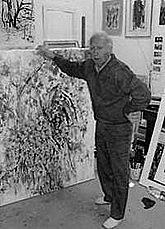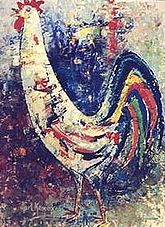
Aart Kemink
Encyclopedia


Rotterdam
Rotterdam is the second-largest city in the Netherlands and one of the largest ports in the world. Starting as a dam on the Rotte river, Rotterdam has grown into a major international commercial centre...
, the Netherlands
Netherlands
The Netherlands is a constituent country of the Kingdom of the Netherlands, located mainly in North-West Europe and with several islands in the Caribbean. Mainland Netherlands borders the North Sea to the north and west, Belgium to the south, and Germany to the east, and shares maritime borders...
.
Kemink studied at Amsterdam's Rijksakademie van Beeldende Kunsten
Rijksakademie
The Rijksakademie van Beeldende Kunsten is a two-year residency for visual artists, based in Amsterdam, The Netherlands.Funded by the Dutch government, residents are granted a stipend and are allotted a personal studio in the former military barracks building in which the Rijksakademie is housed...
(in English: Royal Academy of Visual Arts). After his studies, he shared a studio with the Dutch graphic artist M.C. Escher in the late 1940s, and - in the early 1950s - became a member of the Beroepsvereniging van Beeldende Kunstenaars (known as the BBK or, in English, Union of Visual Artists). During his time in Holland, Kemink also worked with compatriot artist Karel Appel
Karel Appel
Christiaan Karel Appel was a Dutch painter, sculptor, and poet. He started painting at the age of fourteen and studied at the Rijksakademie in Amsterdam in the 1940s...
, best known for his involvement in the Danish-Belgian-Dutch CoBrA
COBRA (avant-garde movement)
COBRA was a European avant-garde movement active from 1948 to 1951. The name was coined in 1948 by Christian Dotremont from the initials of the members' home cities: Copenhagen , Brussels , Amsterdam .-History:...
movement. In 1957, Kemink participated in an exhibition of artists working for the theatre and circus at Amsterdam's nonextant Fodor Museum. While the artist held his own among Amsterdam
Amsterdam
Amsterdam is the largest city and the capital of the Netherlands. The current position of Amsterdam as capital city of the Kingdom of the Netherlands is governed by the constitution of August 24, 1815 and its successors. Amsterdam has a population of 783,364 within city limits, an urban population...
and Rotterdam
Rotterdam
Rotterdam is the second-largest city in the Netherlands and one of the largest ports in the world. Starting as a dam on the Rotte river, Rotterdam has grown into a major international commercial centre...
's artistic elite (a disparate group that included Piet Mondrian
Piet Mondrian
Pieter Cornelis "Piet" Mondriaan, after 1906 Mondrian , was a Dutch painter.He was an important contributor to the De Stijl art movement and group, which was founded by Theo van Doesburg. He evolved a non-representational form which he termed Neo-Plasticism...
, Anton Rooskens, Corneille
Guillaume Cornelis van Beverloo
Guillaume Cornelis van Beverloo , better known under his pseudonym Corneille, was a Dutch artist.Corneille was born in Liege, Belgium, although his parents were Dutch and moved back to the Netherlands when he was 12. He studied art at the Academy of Art in Amsterdam, in the Netherlands...
, and Eugène Brands
Eugène Brands
Eugène Brands was a Dutch painter. He was briefly a member of the Cobra artist movement.In 1946, Eugène Brands participated in the group exhibition "Young Painters" in the Stedelijk Museum in Amsterdam, where a whole room was filled with his work...
), Kemink's reluctance to adopt a style or affiliate with a movement shielded his work from what he considered banal trends in Modern
Modern art
Modern art includes artistic works produced during the period extending roughly from the 1860s to the 1970s, and denotes the style and philosophy of the art produced during that era. The term is usually associated with art in which the traditions of the past have been thrown aside in a spirit of...
and Post-Modern
Postmodernism
Postmodernism is a philosophical movement evolved in reaction to modernism, the tendency in contemporary culture to accept only objective truth and to be inherently suspicious towards a global cultural narrative or meta-narrative. Postmodernist thought is an intentional departure from the...
Dutch painting.
Kemink emigrated to Canada
Canada
Canada is a North American country consisting of ten provinces and three territories. Located in the northern part of the continent, it extends from the Atlantic Ocean in the east to the Pacific Ocean in the west, and northward into the Arctic Ocean...
in 1958, first settling in Brandon
Brandon, Manitoba
Brandon is the second largest city in Manitoba, Canada, and is located in the southwestern area of the province. Brandon is the largest city in the Westman region of Manitoba. The city is located along the Assiniboine River. Spruce Woods Provincial Park and CFB Shilo are a relatively short distance...
, Manitoba
Manitoba
Manitoba is a Canadian prairie province with an area of . The province has over 110,000 lakes and has a largely continental climate because of its flat topography. Agriculture, mostly concentrated in the fertile southern and western parts of the province, is vital to the province's economy; other...
, then finally in Toronto
Toronto
Toronto is the provincial capital of Ontario and the largest city in Canada. It is located in Southern Ontario on the northwestern shore of Lake Ontario. A relatively modern city, Toronto's history dates back to the late-18th century, when its land was first purchased by the British monarchy from...
, Ontario
Ontario
Ontario is a province of Canada, located in east-central Canada. It is Canada's most populous province and second largest in total area. It is home to the nation's most populous city, Toronto, and the nation's capital, Ottawa....
. He eventually became a Canadian citizen.
Kemink's oeuvre is largely abstract and tangentially influenced by the work of Marc Chagall
Marc Chagall
Marc Chagall Art critic Robert Hughes referred to Chagall as "the quintessential Jewish artist of the twentieth century."According to art historian Michael J...
and Willem de Kooning
Willem de Kooning
Willem de Kooning was a Dutch American abstract expressionist artist who was born in Rotterdam, the Netherlands....
. Much of his work of the 1940s and 1950s was affected by World War II
World War II
World War II, or the Second World War , was a global conflict lasting from 1939 to 1945, involving most of the world's nations—including all of the great powers—eventually forming two opposing military alliances: the Allies and the Axis...
and the deleterious effects of the Nazi presence in Holland. During the war, Kemink fought for the Dutch resistance
Dutch resistance
Dutch resistance to the Nazi occupation of the Netherlands during World War II can be mainly characterized by its prominent non-violence, summitting in over 300,000 people in hiding in the autumn of 1944, tended to by some 60,000 to 200,000 illegal landlords and caretakers and tolerated knowingly...
. As a result of his efforts and abilities, he was later commissioned by the City of Amsterdam
Amsterdam
Amsterdam is the largest city and the capital of the Netherlands. The current position of Amsterdam as capital city of the Kingdom of the Netherlands is governed by the constitution of August 24, 1815 and its successors. Amsterdam has a population of 783,364 within city limits, an urban population...
to produce a series of gouaches depicting the city's old Jewish quarters and the tragedy of their destruction (see Holocaust in History of the Jews in the Netherlands
History of the Jews in the Netherlands
Most history of the Jews in the Netherlands was generated between the end of the 16th century and World War II.The area now known as the Netherlands was once part of the Spanish Empire but in 1581, the northern Dutch provinces declared independence...
).
While bucolic representations of Kemink's native Holland figure prominently in his work, the swathes and swatches of colour found in his abstractions - a possible result of his contact with Appel
Karel Appel
Christiaan Karel Appel was a Dutch painter, sculptor, and poet. He started painting at the age of fourteen and studied at the Rijksakademie in Amsterdam in the 1940s...
- dominate his mature work of the last quarter of the twentieth-century. The artist's rarefied palette calls to mind the colour signatures of Chagall
Marc Chagall
Marc Chagall Art critic Robert Hughes referred to Chagall as "the quintessential Jewish artist of the twentieth century."According to art historian Michael J...
, Raoul Dufy
Raoul Dufy
Raoul Dufy[p] was a French Fauvist painter. He developed a colorful, decorative style that became fashionable for designs of ceramics and textiles, as well as decorative schemes for public buildings. He is noted for scenes of open-air social events...
, and André Derain
André Derain
André Derain was a French artist, painter, sculptor and co-founder of Fauvism with Henri Matisse.-Early years:...
, while concomitantly evincing a new force in European émigré Canadian painting.
Despite a paucity of writings about his life or work, Kemink's paintings are highly valued by private collectors in Canada, the United States, and Europe. The artist's work was and continues to be represented in Canada by Maurice Amar, curator of Toronto's Laurier Gallery. It is difficult to gauge the market value of his paintings since they are rare and seldom sold at auction. Kemink's best pieces, however, have been praised and coveted by the National Gallery of Canada
National Gallery of Canada
The National Gallery of Canada , located in the capital city Ottawa, Ontario, is one of Canada's premier art galleries.The Gallery is now housed in a glass and granite building on Sussex Drive with a notable view of the Canadian Parliament buildings on Parliament Hill. The acclaimed structure was...
, the Art Gallery of Hamilton, Toronto's Consulate General of the Netherlands, and art collector Kenneth Thomson. His artistic achievement holds an important place in the history - beginning with Cornelius Krieghoff
Cornelius Krieghoff
Cornelius David Krieghoff is probably the most popular Canadian painter of the 19th century. Krieghoff is most famous for his paintings of Canadian landscapes and Canadian life outdoors, which were sought-after in his own time as they are today. He is particularly famous for his winter scenes,...
in 1840 - of Dutch painting in Canada. Kemink's foreign roots, however, as with those of myriad other artists, became indelibly marked by Canada's passive but persistent influence on the psyche. Despite a career pockmarked by relative obscurity, the quality and significance of Kemink's oeuvre is beginning to come to the fore.
Selected exhibitions
- 1992-2006: Laurier Gallery, Toronto, Canada: New Oils & Works on Paper: Annual Exhibition
- 1957: Fodor Museum, Amsterdam, Netherlands: Painting for the Theatre & Circus: An Exhibition of Work by Amsterdam's Leading Artists
External links
- Stedelijk Museum (National Museum of Modern Art, Amsterdam, Netherlands)
- CoBrA Museum (CoBrA Museum of Modern Art, Amstelveen, Netherlands)
- CODART (Worldwide network of museum curators of Dutch and Flemish art)

